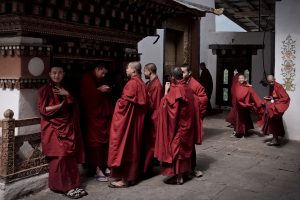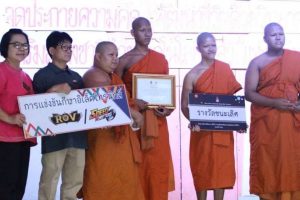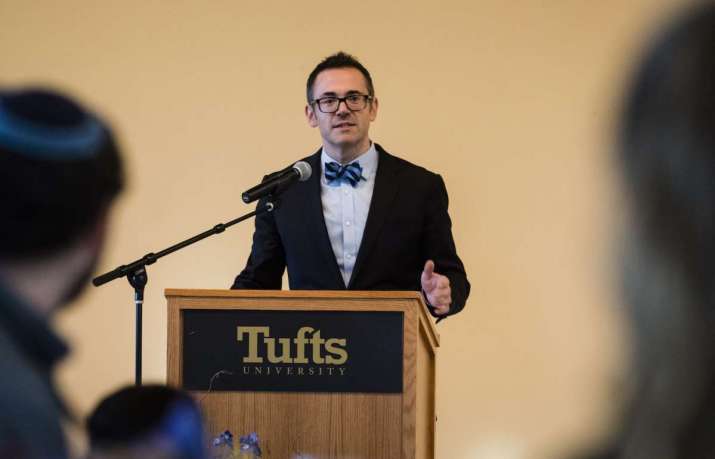
As Buddhism grows in the United States, so does the need for a more pluralistic vision of university chaplaincy in American universities. One man, Reverend Greg McGonigle, university chaplain at Tufts University in Medford, Massachusetts, is pioneering a model of multi-faith university chaplaincy that is breaking new ground by incorporating faith traditions beyond the traditional Judeo-Christian model. Along with a team of seven denominational chaplains, and three chaplain staff members, Reverend McGonigle is leading Tufts toward a more inclusive vision of contemporary religion in the United States today.
Buddhistdoor Global: What is your background and training, and how did you arrive at your vocation and eventually at Tufts?
Reverend GregMcGonigle: I am a Unitarian Universalist minister. I grew up Roman Catholic in a very spiritual family that set me on a path of really valuing spirituality and education. Once I began studying religion I became fascinated by all kinds of different questions about Judaism and Christianity, and also about other religions. When I went to college I started studying different faiths. I took a course on South Asian religions and became fascinated by Hinduism, Buddhism, Sikhism, and Jainism.
I ended up living in India for a while and came to feel that what I was learning about religion in class did not match the reality of what was important to people about their faith on the ground. When I visited a Hindu temple, I didn’t know what people were doing, even though I had studied Sanskrit and taken all these courses in philosophy. So that raised questions for me about what religions really are. While returning from my visit to India, I was reading Diana Eck’s book, Encountering God, which is about thinking of one’s own faith in relation to other faiths and the whole question of lived religion. Religion on the ground sometimes looks very different from what we learn from the official teachings and what is important in terms of doctrine or theology, and I became really fascinated with this aspect.
When I went to graduate school, I worked as a researcher for the Pluralism Project started by Diana Eck at Harvard University, and studied world religions at Rhode Island, documenting many religious centers that had never been documented. That was really exciting to do, along with meeting people in those communities—fascinating people and stories. I ended up deciding that since I had also been close with the college chaplain at Brown University, and realizing that, wow, she gets to study religion and care for people and do social justice work, although I thought I was going to do a Phd I said, “No, I think ministry is the thing.” I had become a Unitarian Universalist and so I started to prepare to do college chaplaincy.
So that is what I have been doing for the past 12–13 years, first at UC Davis in California, where I went for an internship and then stayed on doing multi-faith work right after 9/11. Then I went to Oberlin College and became the first multi-faith director of spiritual life there to expand spiritual life opportunities beyond Jewish, Catholic, and Protestant faiths—a model that was put in place in the 1980s. Then I went to Tufts in 2013 to similarly build on the strong bones that already existed and really to continue expanding the circle in terms of the traditions that we serve in the chaplaincy.
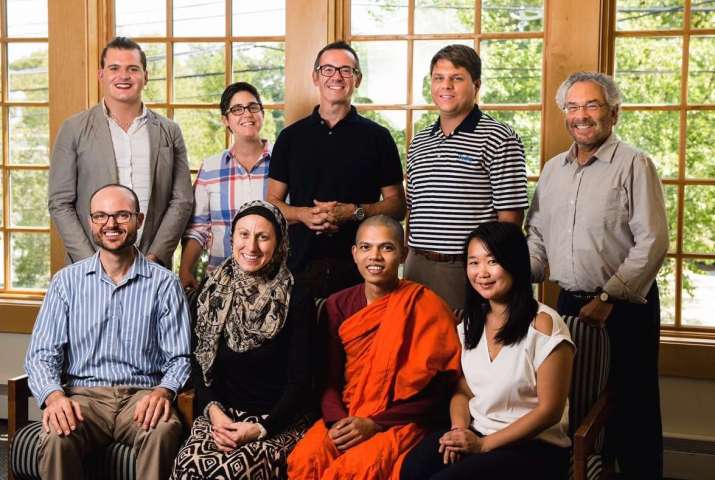
BDG: How are you manifesting this expansion beyond the Judeo-Christian traditions within university chaplaincy? What is that vision?
RGM: I think we are figuring it out as we go; we are making the path by walking it in the Tufts University Chaplaincy, which is modeled in part by strong work that was already starting at Brown University. Brown was one of the first schools to have a Muslim chaplain paid by the university, so it was kind of an initial expansion. They do some exciting work at Brown around Contemplative Studies, which is connected to the chaplaincy, but also in the Religion Department. Wellesley College near Boston was one of the first to really develop a pluralistic chaplaincy team with a Hindu chaplain, a Buddhist chaplain, and a Unitarian Universalist, and traditions that aren’t always represented.
We seek to be a pluralistic model, and I think that our chaplaincy team is almost an inter-faith community in and of ourselves. We are building relationships, learning about one another, engaging, finding common ground, honoring differences among ourselves, and also serving a campus out of our own traditions—but really also representing our traditions and teaching them, nurturing those traditions, really for all students, faculty, and staff.
That is our goal because we don’t see it as a sectarian model in which the Buddhist chaplain only works with Buddhists, or the Catholic chaplain only works with Catholics. Each of our chaplains, even though we each have a tradition that we belong to, of course have many interests around spirituality, activism, our own personal stories, our personal identities, and that helps to create the mosaic of spiritual life that we offer and hope to cultivate.
BDG: Why is it important in the United States to provide this kind of multi-faith environment for university students, faculty, and staff?
RGM: The United States is one of the most religiously diverse countries in the world, and a country in which religion is a very salient part of civic discourse, public discourse, and people’s personal lives on a day-to-day basis. Really, religious, non-religious, or spiritual—however people identify—I think the role of religion and spirituality and society is there for everyone, in one way or another. So, just from an intellectual point of view, I think it’s critically important to understand religion. Often religion goes with culture, and so when we talk about understanding Buddhism we are also talking about understanding cultures that have been shaped by Buddhism for thousands of years.
It’s cultural literacy, but it’s also about people trying to make meaning in their own lives and thinking about how to live—how to live an inspiring life that makes a difference. And I think these wisdom traditions really offer ancient insights for doing so that are very appealing to college students today, and to the faculty and staff that are part of the university community.
If anything, I am seeing an increase in interest in spirituality and religion. People are also talking about a decrease in identifying: people aren’t identifying with a single tradition anymore. I think that more and more, as we are part of a multi-cultural, globalized world reality—an interconnected world, all of our identities are a mixture of different cultures, different insights, different art that we have experienced, and it all shapes who we are.
We hear from students that they learn a lot from their classes, but they are also trying to learn how to become good human beings, and to put a life together. And that is what I see religious life in the university being about—how do I put together a life of meaning? Part of that is being educated, but part of it is cultivating the heart, thinking carefully about the world, thinking about the insights that people have had, about human nature and how to make a difference in the world for thousands of years, of which religious traditions are the bearers.
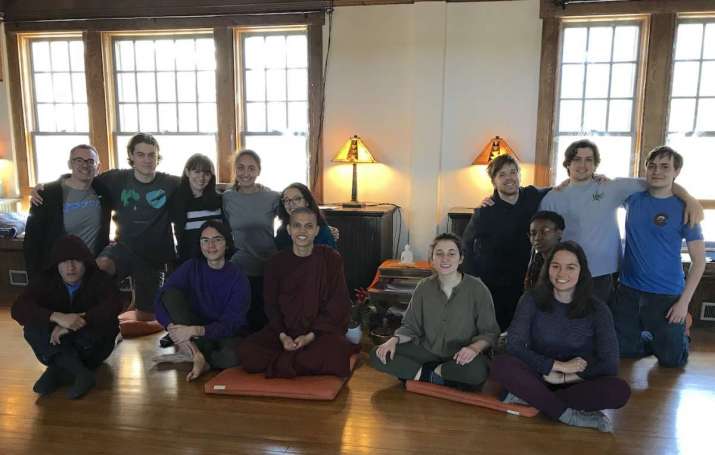
In the history of chaplaincy in the US, a lot of institutions including Tufts were founded by religious denominations. Tufts was founded by Universalists, my own tradition, more than 100 years ago. There was a sense of educating the whole person at that time. Even though we have been through many changes since then, for example in the 1960s, and with multiculturalism and post-modernism. Things have changed, but I think the impetus, the need that gave rise to those structures, is still desired by many people. What we are trying to do is offer a chapel, an interfaith center that offers many different pathways that might be appropriate to the wide diversity of students we now have.
In the past, the student body was more homogenous, so the spiritual life could be more homogenous. But the reality of students on campuses in the US since 1965 reflects the religious diversity of the world in a real way, and so the support for that really needs to reflect this diversity. Part of my personal passion in my career is to help to try to make that happen.
I have studied many religions deeply and have found so much to admire in them. I’ve also created friendships in different faiths and I know that people coming from traditions such as Islam, Hinduism, and Buddhism are serious about their traditions and want to stay connected with it in college, and need the resources to be able to do so. And so finding a way to get institutions to change to meet that reality has been part of my personal mission—to midwife that transformation.
BDG: Thank you Rev. McGonigle. May such a generous and inclusive vision of university chaplaincy inspire more work toward accommodating and supporting the reality of American religiously diversity in our institutions!
See more
University Chaplaincy (Tufts)
The Pluralism Project (Harvard University)





